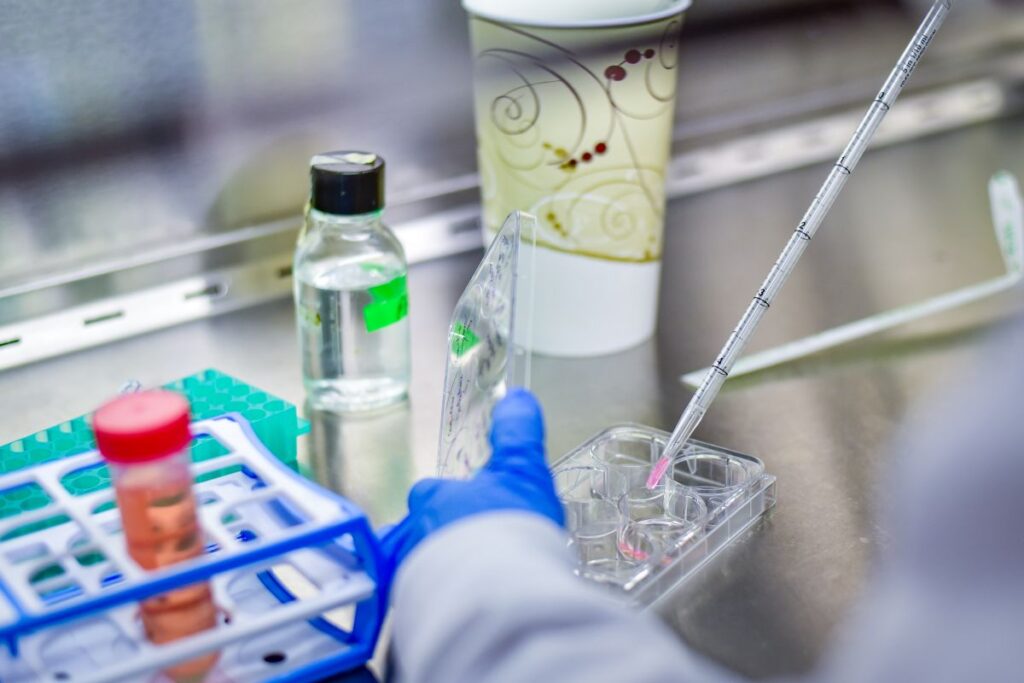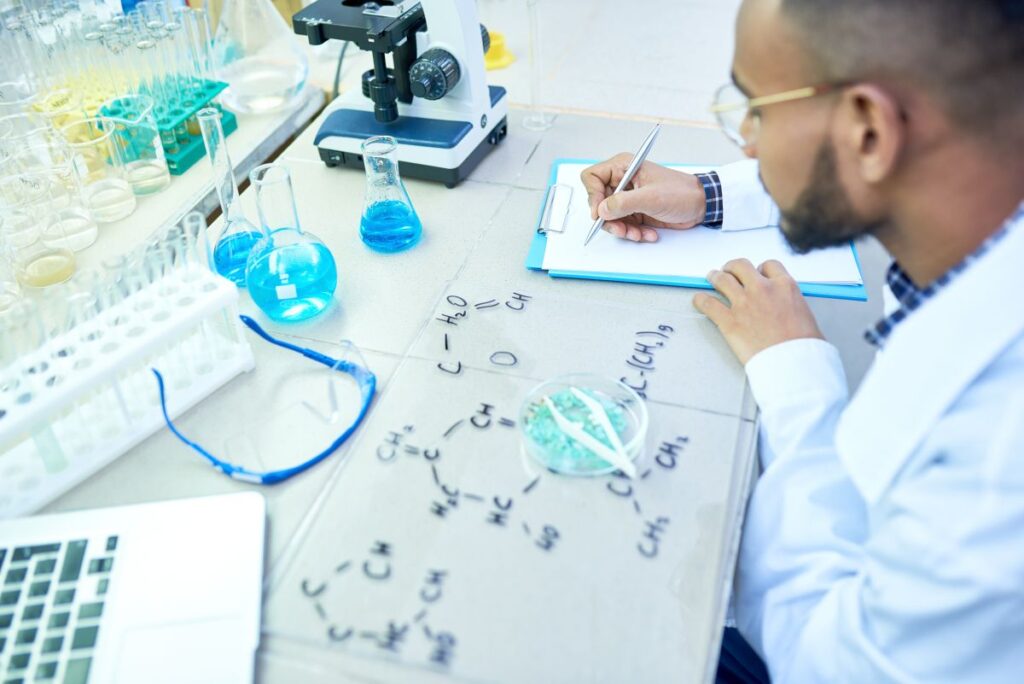An Overview of AHCY Gene and Its Enzymatic Activity in Homocysteine Metabolism
The human body’s biochemical processes are complex, and a pivotal component among these is the AHCY gene, which encodes the adenosylhomocysteine hydrolase enzyme. This enzyme plays a critical role in homocysteine metabolism, a process integral to maintaining cardiovascular health.
Through its activity, adenosylhomocysteine hydrolase acts upon homocysteine, a sulfur-containing amino acid that can accumulate to harmful levels if not properly metabolized.

The catalytic action of adenosylhomocysteine hydrolase ensures homocysteine is efficiently converted, crucially staving off the risk of adverse health outcomes including thrombosis, where blood clots form in blood vessels, potentially leading to life-threatening episodes.
In humans, the AHCY gene’s function is not a trivial matter. It’s directly involved in the methylation cycle, a fundamental pathway for numerous physiological processes. The activity of the enzyme it encodes operates meticulously to deplete adenosylhomocysteine, a byproduct of methylation reactions, through hydrolysis to adenosine and homocysteine.
Adenosine, another important player in various metabolic processes, is further broken down, while homocysteine may be re-methylated to methionine or channeled towards the transsulfuration pathway. These pathways are tightly regulated, and the activity of enzymes like adenosylhomocysteine hydrolase is pivotal for their efficient operation.
However, it’s the breakdown in this enzyme’s activity that’s of particular concern. Genetic variations in the AHCY gene can lead to dysregulation in homocysteine levels.
Elevated homocysteine is closely linked with an increased risk of thrombosis, due to its propensity to inflict damage on vascular endothelial cells and promote thrombotic tendencies. This makes studying and understanding how the AHCY gene’s activity is modulated not only scientifically compelling but also medically vital.
In humans, mutations in the AHCY gene can result in a reduced capacity for the enzyme’s activity, illustrating how delicate the balance of homocysteine metabolism is.
The activity of adenosylhomocysteine hydrolase is subject to regulation at multiple levels, ensuring it operates within a fine balance. Factors that influence its expression, stability, and activity are of significant research interest, with implications for therapeutic targets.
Inhibitors of this enzyme are looked at for their potential to influence the methylation status of cells, which in turn can affect gene expression patterns and disease progression.
To conclude, the human AHCY gene encodes the enzymatic power of adenosylhomocysteine hydrolase, which maintains homocysteine levels in a precise equilibrium essential for health.
Exploring the AHCY gene and the enzyme it encodes is not simply an academic endeavor but a stride towards understanding human health intricacies. As research progresses, the hope is to unveil strategies that can sway homocysteine metabolism in our favor, reducing the likelihood of thrombosis and associated risks.
It’s through the diligent study of enzymes like adenosylhomocysteine hydrolase that we can develop a keener insight into their activity and the genetic nuances that govern them, helping pave the way for advancements in medical science.
| Overview of AHCY Gene and Its Enzymatic Activity | |
|---|---|
| Name and Location | AHCY (Adenosylhomocysteinase), located on human chromosome 20q11.23. |
| Gene Function | Encodes for the enzyme adenosylhomocysteinase, which is involved in the methionine cycle. |
| Enzymatic Activity | Hydrolyzes S-adenosylhomocysteine (SAH) to adenosine and homocysteine. |
| Enzymatic Importance | Crucial for the regulation of the intracellular concentration of SAH and homocysteine, which in turn affects the methyltransferase reactions. |
| Role in Homocysteine Metabolism | Its activity maintains homocysteine levels for its subsequent conversion to methionine or cysteine. |
| Pathway Connection | Interconnects methionine cycle, transsulfuration pathway, and polyamine synthesis. |
| Implications of Dysfunction | Deficiencies may lead to hyperhomocysteinemia, which is associated with cardiovascular and neurological disorders. |
| Genetic Disorders | Genetic mutations can cause AHCY deficiency—a rare inborn error of metabolism. |
| Therapeutic Relevance | Target for drugs aiming to control homocysteine levels to prevent or treat related disorders. |
The Influence of AHCY on Human Homocysteine Levels and Thrombosis Risk
The AHCY gene, encoding the enzyme adenosylhomocysteine hydrolase, stands at a crucial juncture in human metabolism, particularly concerning amino acid processing and cardiovascular health. The enzyme produced by the AHCY gene is pivotal in homocysteine metabolism, directly influencing human homocysteine levels.
Errant activity of this enzyme can lead to disruption in normal levels, precipitating a cascade of health concerns, with thrombosis risk sitting prominently among them. Homocysteine, an amino acid in blood, is intricately tied to the well-being of cardiovascular systems, and the AHCY gene’s role in its regulation cannot be understated.
Human biology dictates that the AHCY enzyme mediates the conversion of S-adenosylhomocysteine to homocysteine, a process essential for maintaining a balanced internal environment. Deficiencies in AHCY gene expression or its enzymatic activity can result in aberrant homocysteine accumulation, thereby emphasizing the importance of the AHCY gene in averting the risks associated with elevated levels, such as endothelial dysfunction and a predisposition to clot formation.
This then elucidates the gene’s indirect but significant contribution to thrombosis risk. In humans, homocysteine levels are a widely recognized marker for cardiovascular risk assessment, and a genetically rooted deficiency in AHCY activity is a key contributor to hyperhomocysteinemia.
Deficiency in the AHCY gene can have a severe impact on an individual’s health, not just in terms of elevated homocysteine but also concerning the broad implications it holds for cardiovascular health.
With the activity of AHCY pivotal to homocysteine clearance, deficiencies can lead to considerable complications, including an increased thrombosis risk due to the prothrombotic state induced by hyperhomocysteinemia.
As such, this gene’s regulation and the enzymatic activity it governs are of paramount importance in both genetic counseling and therapeutic intervention. It’s the delicate balance maintained by the AHCY’s normative function that averts the myriad complications associated with its deficiency.

Further, research elucidating the ahcy gene’s relationship with homocysteine and thrombosis risk highlights the gene’s potential as a marker for cardiovascular diseases. Evidence suggests that even modest perturbations in AHCY activity, often rooted in genetic variations of the AHCY gene, could tilt the scale towards a heightened risk for thrombotic events.
This illustrates that the enzyme adenosylhomocysteine hydrolase is not just an ancillary player but a central figure in human homocysteine metabolism and, by extension, thrombosis risk management.
In summary, the AHCY gene’s product, adenosylhomocysteine hydrolase, is integral in maintaining appropriate human homocysteine levels and, consequently, mitigating thrombosis risk. The AHCY’s deficiency, rooted in genetic aberrations, can compromise this delicate balance, signaling a need for deeper examination within the medical field.
Understanding the nuanced roles and the implications of deficiencies engendered by the AHCY gene, remains vital in combating the prevalence of heart diseases and offers direction for future research and potential therapeutic targets.
- Role of AHCY in Homocysteine Metabolism: AHCY is critical in converting S-adenosylhomocysteine (SAH) to homocysteine, a vital step in homocysteine metabolism.
- Genetic Variations in AHCY: Specific genetic polymorphisms in the AHCY gene can influence enzyme activity, which may lead to altered homocysteine levels.
- Homocysteine Accumulation: Decreased AHCY activity or expression can result in elevated homocysteine levels, known as hyperhomocysteinemia.
- Impact on Cardiovascular Health: Elevated homocysteine levels have been associated with an increased risk of thrombotic events, contributing to cardiovascular disease.
- Nutritional Influences: Nutrient deficiencies, particularly of vitamins B6, B12, and folate, can exacerbate the impact of AHCY on homocysteine levels due to their role in homocysteine metabolism.
- Enzyme Cofactors: S-adenosylmethionine (SAM) acts as a cofactor for AHCY, and its availability can influence AHCY enzyme activity and thus homocysteine levels.
- Lifestyle Factors: Lifestyle factors, including diet, exercise, and smoking, can affect AHCY activity and homocysteine levels, potentially modifying thrombosis risk.
- Drug Interactions: Certain medications can inhibit AHCY activity, leading to increased homocysteine concentrations and a potential rise in thrombotic risk.
- Diagnostic Biomarker: AHCY and homocysteine levels are often measured as biomarkers for cardiovascular risk assessment in clinical settings.
- Therapeutic Target: AHCY’s role in homocysteine metabolism makes it a potential target for therapeutic interventions aimed at reducing thrombosis risk.
- Methionine Cycle Regulation: AHCY is a key regulator of the methionine cycle, and its regulation is essential for maintaining balanced homocysteine levels.
- Intervention Studies: Clinical studies have explored the use of vitamin supplementation to reduce homocysteine levels and mitigate AHCY’s influence on thrombosis risk.
- Sex-Dependent Differences: Research indicates potential sex-dependent differences in AHCY expression and activity, which may affect homocysteine levels and thrombosis risk differently in men and women.
- Age-Related Changes: Aging can impact AHCY activity and, consequently, homocysteine levels, influencing thrombosis risk in the elderly population.
- Research Frontiers: Ongoing research is examining the detailed mechanisms of AHCY’s role in homocysteine metabolism and its relationship with thrombosis risk.
Elucidating the Biological Function and Regulation of AHCY Activity
The biological function and regulation of the AHCY gene, which encodes the adenosylhomocysteine hydrolase enzyme, are critical to understanding its role in human health and disease.
This enzyme is a pivot in the homocysteine metabolism pathway; its primary activity entails the hydrolysis of S-adenosylhomocysteine (SAH) into adenosine and homocysteine, which is a crucial reaction in the regulation of methylation processes within cells.
In humans, the functionality of adenosylhomocysteine hydrolase is indispensable for maintaining homocysteine levels within a narrow range, as perturbations can lead to health issues, including an enhanced risk of thrombosis.
Studies have demonstrated that genetic variations within the AHCY gene can profoundly affect the enzyme’s activity and consequently, the homocysteine concentration in the bloodstream. The enzyme’s activity is intricately regulated at the genetic level, and gaining more information about this regulation can provide insights into its contribution to thrombotic disorders.
Adenosine, which is produced as a byproduct of the AHCY gene’s enzymatic action, plays its own role in the body, including involvement in energy transfer as well as signal transduction pathways.
However, it’s the balance of homocysteine levels that’s primarily linked to the risk of thrombosis. Elevated homocysteine can be prothrombotic, and researchers are keen on understanding how adenosylhomocysteine hydrolase activity can either mitigate or contribute to this risk.
From a genetic standpoint, mutations or polymorphisms in the AHCY gene can lead to a loss or reduction in enzyme activity, which, in turn, can result in hyperhomocysteinemia and an increased risk of vascular diseases.
Thus, genetic screening and information gathered from studies on the AHCY gene can be instrumental in identifying individuals at risk of developing conditions associated with abnormal homocysteine metabolism.

Furthermore, the adenosylhomocysteine hydrolase enzyme is not just a passive participant; its activity can be influenced by numerous factors, such as nutritional status, particularly folate and B-vitamins levels. These nutrients are crucial co-factors for enzymes in the homocysteine metabolism pathway.
Understanding how these dietary factors regulate AHCY activity could provide yet another layer of intervention for managing homocysteine levels and reducing thrombosis risk. Moreover, since adenosine and homocysteine both have significant biological roles, the study of the AHCY gene sheds light on a wider spectrum of physiological processes beyond just thrombosis, ranging from neuromodulation to immune response.
The biological function of adenosylhomocysteine hydrolase, as decreed by the AHCY gene, is a cornerstone in the control of homocysteine levels, and by extension, human health. It’s not just about the activity of the enzyme, but the genetic and external factors that regulate this activity, offering a complex yet fascinating glimpse into how our bodies maintain balance.
Scientists continue to unravel the information embedded in the AHCY gene, and this knowledge is paramount to devising preventive measures and therapeutic strategies for thrombosis and related disorders resulting from disrupted homocysteine metabolism.
With every discovery, we step closer to personalized and precise medical interventions, highlighting the importance of genetic information in guiding clinical practice.
Genetic Information Related to AHCY and Its Impact on Gene Expression
The AHCY gene, encoding the enzyme adenosylhomocysteine hydrolase, plays a pivotal role in human homocysteine metabolism, with significant implications for genetic health and disease. This gene’s genetic information is critical as it determines the enzyme’s activity, influencing the balance of homocysteine in the body.
Homocysteine, a byproduct of methionine metabolism, can contribute to thrombosis risk if its levels become imbalanced. In human biology, the study of the AHCY gene has revealed intriguing insights into gene expression patterns and the regulation of enzymatic functions.
Studies on AHCY have elucidated a genetic framework where the efficiency of adenosylhomocysteine hydrolase is directly impacted by variations within the AHCY gene sequence. Such genetic information can predispose individuals to different levels of activity of this enzyme, which in turn modulates homocysteine levels and thus potentially affects thrombosis risk.
Detailed genetic information about the AHCY gene, such as single nucleotide polymorphisms (SNPs), is of immense interest because these variations can lead to altered gene expression and consequent fluctuations in enzymatic activity.
It’s this intricate interplay between genetic information and gene expression that underscores the importance of the AHCY gene in human health.
Furthermore, the regulation of AHCY gene expression is multifaceted, involving various genetic and epigenetic mechanisms. The genetic aspects of AHCY contribute to how the gene is transcribed and the adenosylhomocysteine hydrolase is produced, affecting its activity within homocysteine metabolism.
The genetic information encoded by AHCY is thus a determinant of how effectively the gene’s product can modulate homocysteine levels and potentially lower thrombosis risk. An understanding of this genetic information also guides the development of targeted therapies to manage conditions associated with elevated homocysteine levels.
Examination of the AHCY gene in the context of human genetics offers a deeper comprehension of its expression patterns and their consequences. By interpreting the genetic information of the AHCY gene, researchers can assess the individual variability in adenosylhomocysteine hydrolase activity and its impact on homocysteine metabolism. In doing so, they unravel the gene’s nuanced roles in predisposing humans to varying levels of thrombosis risk.
The AHCY gene, via its product adenosylhomocysteine hydrolase, is intimately involved in the complex machinery of human gene expression and enzyme activity that regulates critical aspects of homocysteine metabolism. The genetic information harbored in the AHCY gene provides a blueprint for the enzyme’s activity, influencing homocysteine levels and modulating thrombosis risk.
Consequently, a deep dive into the genetic and functional nuances of the AHCY gene is essential for deciphering the interplay between genetic predisposition, enzyme function, and disease susceptibility, particularly in relation to cardiovascular health.
Structural Insights into the AHCY Enzyme: From Genes to Proteins
The AHCY gene, encoding for the enzyme adenosylhomocysteine hydrolase, is a pivotal component in the intricate workings of homocysteine metabolism within the human body. Astutely orchestrating the breakdown of adenosine and homocysteine, AHCY plays an indispensable role in maintaining balance and preventing the accumulation of harmful byproducts that can contribute to thrombosis risk.

Interpreting the structural aspects of this enzyme provides us with profound insights into its activity and overall functionality. At the molecular level, AHCY’s gene sequence lays the blueprint for the synthesis of a dynamic protein, which, through its catalytic activity, mitigates the potential elevation of homocysteine levels that is often associated with cardiovascular diseases.
Recent studies focusing on adenosylhomocysteine hydrolase have unveiled a wealth of information regarding the human AHCY gene and its various polymorphisms that may influence enzyme activity.
This information is crucial for understanding the genetic predisposition towards impaired homocysteine metabolism, potentially leading to thrombogenic disorders.
Through detailed analysis, it has become clear that the activity of AHCY is finely regulated at both the genetic and enzymatic level, ensuring the efficiency and precision of adenosine recycling.
The genetic makeup encapsulated within the AHCY genes provides the necessary instructions for the formation of a functional hydrolase, which then mediates a critical reaction in the methylation pathway.
The intricate relationship between AHCY, its gene, and the resulting enzyme elucidates the complexity of the regulation pathway that dictates its activity. This regulation is further understood when examining the genetic information that controls AHCY expression and ultimately determines the gene’s impact on the cell’s metabolic network.
Much of this valuable information has been gleaned from computational biology and other advanced scientific methodologies, propelling our knowledge of AHCY and its associated genes forward.
Interestingly, both the stability and activity of the AHCY enzyme are influenced by the level of proteins expressed from the AHCY genes, highlighting an intricate interdependency between gene regulation and protein function.
The significance of maintaining a fine-tuned balance in AHCY activity is evidenced by the potential consequences of its dysregulation. Excessive or insufficient enzymatic activity can lead to aberrant levels of homocysteine, thus raising the thrombosis risk in affected individuals.
Such findings underscore the importance of genetic and functional studies in predicting the propensity for thrombotic events and implementing preventive strategies in human health.
Moreover, understanding the structure of the AHCY enzyme down to its atomic composition permits the delineation of the active site and helps in predicting how variants in the AHCY gene may alter the enzyme’s activity.
Knowledge about these structural variations is indispensable when considering the design of targeted therapeutics aimed at modulating enzyme activity to mitigate thrombosis risk. This level of detailed information concerning the AHCY hydrolase transforms our capacity to personalize medicine based on an individual’s unique genetic profile.
In conclusion, the AHCY gene and the protein it encodes collectively form a vital cog in the machinery of homocysteine metabolism. The activity of adenosylhomocysteine hydrolase is not only critical for human health but also serves as an indicator for potential thrombosis risk, solidifying the gene’s significance.
Such comprehensive genetic and functional elucidations regarding AHCY activity, protein structure, and gene regulation are fundamental in crafting novel interventions and therapeutic approaches that could significantly impact human well-being and disease prevention.
A more profound understanding of AHCY generated by such research provides a pathway to improved health outcomes and underscores the importance of genetic information in the ever-evolving domain of personalized medicine.
Exploring the Interaction of AHCY with Other Genes in Metabolic Pathways
The AHCY gene plays a pivotal role in human metabolism, particularly in the catabolism of homocysteine, a process crucial for cardiovascular health and preventing thrombosis.
Adenosylhomocysteine hydrolase, the enzyme encoded by the AHCY gene, works concertedly with other genes and their corresponding enzymes to maintain a delicate balance in homocysteine levels.

This hydrolase’s activity is instrumental in facilitating the conversion of adenosine and homocysteine into other necessary compounds that are vital for various bodily functions.
It’s no surprise, then, that alterations in AHCY’s function can profoundly impact metabolic pathways, potentially leading to a predisposition for thrombotic events.
The intricacy of metabolic regulation is underscored by the interaction of the AHCY gene with genes involved in the methionine cycle, such as MTHFR, MAT, and CBS.
The synergy among these genes is fundamental to ensuring the proper flux of one-carbon metabolism. It is a symphony of genetic interactions where each gene, including AHCY, contributes its unique note – either through enzyme activity modulation or through feedback mechanisms that adapt to the body’s metabolic demands.
The centrality of AHCY in this process means that the gene’s regulation is equally vital to understand, as AHCY’s activity cascades through homocysteine metabolism and affects the entire web of metabolic pathways.
In order to fully appreciate the complex nature of these interactions, an in-depth exploration of the genetic information related to AHCY provides valuable insights. Genetic expression patterns reveal how AHCY activity is modulated under varying physiological conditions.
When the body’s demand for homocysteine clearance is heightened, AHCY’s expression is upregulated, thereby enhancing its enzyme activity. On the flip side, when the metabolic landscape necessitates a conservation of methionine-derived adenosine, AHCY’s activity is finely tuned to recalibrate homocysteine levels.
In the context of thrombosis risk, since homocysteine poses a threat when accumulated, it’s essential to acknowledge that AHCY doesn’t operate in isolation. Its interaction with the aforementioned genes is also a focal point for therapeutic intervention.
By delineating the nuances of how AHCY activity modulates homocysteine metabolism and interacts with other genes, researchers can identify potential targets for drugs aimed at mitigating thrombosis risk; it could be as direct as influencing AHCY’s hydrolase activity or as indirect as altering the expression of related genes.
Thus, decoding the intricate genetic web spun around AHCY’s enzymatic role is more than an academic pursuit – it’s a gateway to potentially life-saving medical advancements.
Ultimately, a comprehensive understanding of the metabolic pathways governed by AHCY and its interactions with other genes paves the path to proactive health management.
Whether it’s tailoring diet to support methylation or developing medications that can fine-tune AHCY activity, the potential to influence human health is profound. After all, by painting a clearer picture of the genetic interactions involved in homocysteine regulation, we’re better equipped to address the underlying causes of thrombosis and safeguard our vascular well-being.
In this genomic era, genes such as AHCY are not just isolated sequences of DNA but are part of an interconnected landscape that powerfully dictates our health outcomes.
Investigating the Role of AHCY in One-Carbon Metabolism
The AHCY gene, encoding the enzyme adenosylhomocysteine hydrolase, is a pivotal player in the one-carbon metabolism network – a pathway central to the proper functioning of various biological systems in the human body.
Adenosylhomocysteine hydrolase acts as a key regulator by ensuring the continuous conversion of adenosine and homocysteine, both crucial substrates in cellular reactions. This hydrolase activity is instrumental in maintaining a delicate balance within the methylation cycle, directly impacting gene expression and the body’s epigenetic landscape.
Exploring the AHCY gene provides essential information about how this enzyme influences the intricate tapestry of one-carbon metabolism. The role of this gene is further highlighted through its connection to homocysteine levels, which, if not properly regulated, can lead to an increased risk of thrombosis and other cardiovascular conditions.
Understanding the metabolic pathways orchestrated by AHCY involves dissecting how adenosine and homocysteine are metabolized, a process that is fundamentally dependent on the activity of this hydrolase.
Research has revealed the depth and complexity of the AHCY gene’s contribution to homocysteine metabolism. Its genetic variants can lead to varied expressions and consequential alterations in enzyme activity.
Investigations into the biological function and regulation of AHCY offer great promise for understanding the broader implications of its activity in human health. Tracking the conversion of S-adenosylhomocysteine to homocysteine and adenosine paves the way for new insights into cellular mechanisms and the potential development of therapeutic interventions for those with abnormal gene expressions affecting one-carbon metabolism.
The AHCY gene’s significance in metabolism also lies in its interplay with other genes, typifying the complex interaction network of metabolic pathways. Such interactions underscore the gene’s role in orchestrating a symphony of metabolic processes.
Genetic information detailing variations in the AHCY can elucidate additional layers of influence on overall metabolic function and how these may contribute to thrombosis risk.
Moreover, structural insights into the AHCY enzyme gleaned from the study of genes to protein formations deepen our understanding of its functional mechanisms.
The AHCY gene stands at the crossroads of metabolism and genetics. Its activity as a hydrolase is a cornerstone of one-carbon metabolism, influencing everything from amino acid processing to the synthesis of nucleotides.
As research progresses, we’re likely to uncover even further how AHCY’s function within this essential metabolic pathway affects human health, potentially offering new avenues for managing diseases related to homocysteine levels and thrombosis risks.
The continuous study of the AHCY gene and its metabolic role is not just about examining a single entity in a complex system, but rather, it’s about unraveling the broader canvas of human biology and the molecular intricacies that underpin our very existence.
AHCY Mutations and Their Implications in Human Health and Disease
The AHCY gene, which encodes the enzyme adenosylhomocysteine hydrolase, plays a critical role in human health due to its involvement in homocysteine metabolism.

Mutations within the AHCY gene can cause deficiencies in enzyme activity, subsequently leading to an increased risk of thrombosis and other related health complications.
AHCY deficiency is therefore not just a genetic concern but one with tangible implications for health and disease. As researchers delve into the genetic landscape of the AHCY gene, they are discovering various mutations that have a direct impact on the function of adenosylhomocysteine hydrolase.
These discoveries are significant because the enzyme plays a pivotal role in the regulation of homocysteine levels within the body.
Besides its contribution to metabolic pathways, an AHCY deficiency can give rise to elevated levels of homocysteine, which is known to be a risk factor for thrombosis. This condition, affecting coagulation, further underscores the importance of genetic screening for mutations in the AHCY gene, especially in populations susceptible to cardiovascular diseases.
Furthermore, the impact of AHCY mutations extends beyond the enzymatic domain and touches upon the overall expression of genes related to homocysteine metabolism and one-carbon pathways.
It’s essential to recognize that an AHCY mutation could change the gene’s expression profile, which in turn, can alter the metabolic balance within the human body, demonstrating the interconnectedness of genetic information and functional outcomes.
When considering the implications of these mutations on human health, it’s clear that AHCY’s role is not isolated. The interplay between AHCY and other genes within metabolic pathways points to a more complex network that requires careful examination to understand the full impact of genetic alterations.
Structural insights into the AHCY enzyme have revealed how specific gene mutations can alter the configuration and, consequently, the activity of this crucial enzyme. From genes to proteins, the structure-function relationship of AHCY is essential in maintaining the delicate balance of homocysteine levels in the human body.
Investigating AHCY’s role in human health and disease also involves understanding its participation in one-carbon metabolism, a critical cellular process that encompasses various aspects of cell growth and function.
Mutations leading to enzymatic deficiencies could have profound implications on this metabolic pathway, which in turn can affect a multitude of physiological processes. This points to the significance of the AHCY gene as not merely a genetic marker but as a fundamental contributor to metabolic integrity and health outcomes.
In conclusion, understanding the genetic and functional aspects of the AHCY gene is essential for a comprehensive picture of its role in homocysteine metabolism and associated disease risks. T
he implications of AHCY mutations on human health highlight the importance of ongoing research in this field, aiming not just to identify genetic variants but also to elucidate their clinical relevance.
By understanding the genetic impact on the expression of this gene and others within its network, scientists and healthcare professionals can develop better strategies for managing and preventing the adverse effects associated with AHCY deficiencies, ultimately improving patient outcomes.
